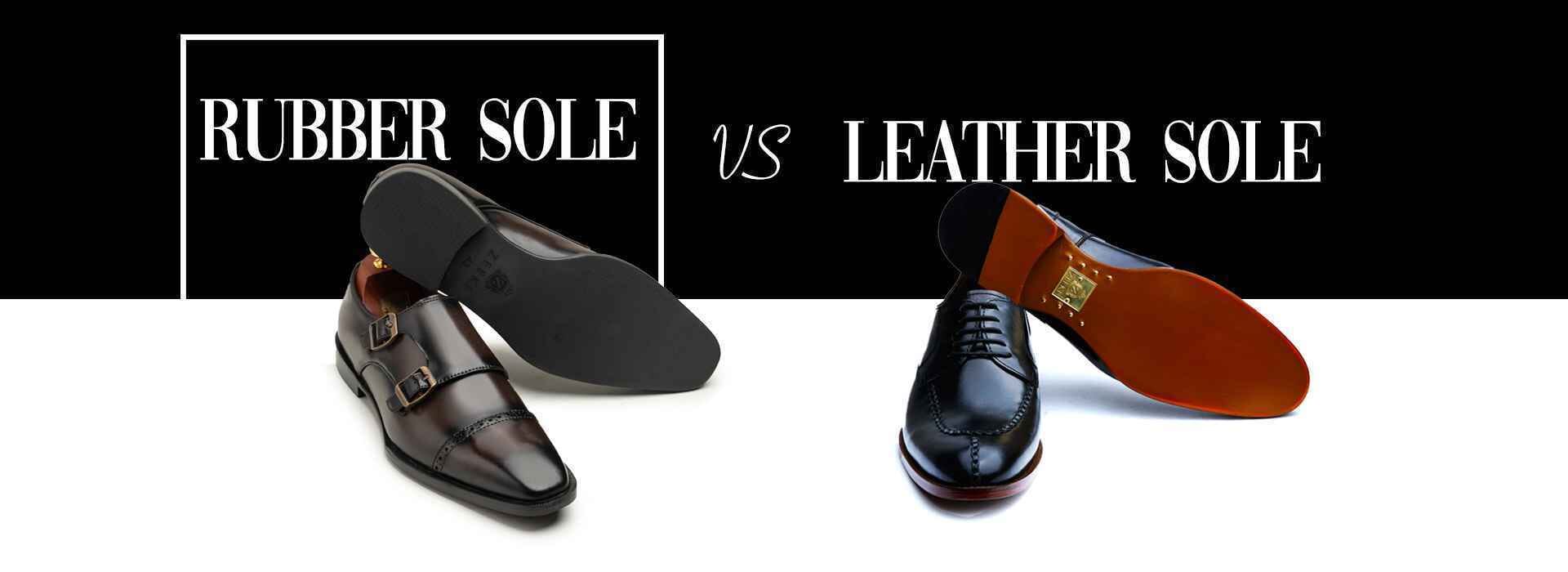Rubber Sole Shoes vs. Leather Sole Shoes

Introduction
In the world of footwear, deciding between Rubber Soles Shoes and leather soles is about more than just visual appeal. Each type has distinct advantages and disadvantages that affect comfort, durability, and overall style. Let us examine the subtle differences between rubber-soled shoes and leather-soled shoes so that you can make a wise choice for your next shoe purchase. Which shoe sole is best for you?
Understanding Rubber Sole Shoes With Pro's & Cons
The Comfort Quotient
Rubber Soles are best known for their cushioning properties, providing a comfortable and shock-absorbing base. This makes them ideal for long hours of walking or standing, ensuring a pleasant experience for your feet.
Durability Matters
Rubber soles are incredibly resilient and can withstand a lot of wear and tear. Whether you're walking city streets or rough terrain, rubber soles provide a reliable and durable solution that makes them suitable for everyday use.
Traction and Grip
One of the standout features of rubber sole shoes is their excellent traction. The grip they provide makes them a preferred choice for various activities, especially in wet or slippery conditions, enhancing stability and reducing the risk of slips and falls.
Rubber Sole Pro's
Rubber typically feels less stiff when a shoe is made on a rubber sole, even if it is handwelted; additionally, because it is fairly sturdy, it may feel comfortable on some feet; and lastly, because rubber naturally absorbs more shock, you do not feel the hardness of the pavement as much as you might in a leather sole.
Rubber Sole Cons
Whether marketed as natural or synthetic, rubber lacks the ability to conform to your foot like a leather sole does. This means that although the insole may mold to your feet, the sole never does, and the rigidity of that lack of shape-taking can feel quite uncomfortable over time. In other words, a rubber sole may feel comfortable at first but, if you were to wear it all day, the non-forming rigidity of the rubber would start to wear out your feet.
Understanding Leather Sole Shoes With Pro's & Cons
Timeless Elegance
Leather Sole Shoes exude a timeless and sophisticated charm. If you're aiming for a classic, formal look, leather soles add a touch of elegance to your ensemble, making them a staple in dress shoes.
Flexibility and Molding
Leather soles have a unique ability to mold to the shape of your foot over time. This results in a personalized fit, offering unparalleled comfort and a bespoke feel that enhances with each wear.
Breathability
Unlike some rubber soles, Leather Soles allow your feet to breathe. This breathability prevents excess moisture buildup, keeping your feet cool and comfortable even during extended wear.
Leather Sole Pro's
The misconception about sole leather is that it is a hard material that does not allow for cushioning or comfort. However, this misconception ignores the fact that, even though sole leather was intended to be hard, it is still just skin, and as such, it can mold and shape to your foot, allowing natural contours to occur (since it is a natural product). When combined with cork, sole leather can create a very flexible and soft footbed that actually provides much more comfort than its rubber counterpart—that is, assuming that the arch support is appropriate.
Leather Sole Cons
A thin-soled, blake-stitched, flat last (no arch support) will be one of the most uncomfortable experiences ever; on the other hand, a double leather sole, Goodyear welted shoe made on a last with proper arch support will be among the most comfortable shoes around. A thin-soled, blake-stitched shoe without cork combined with a thin sole can be extremely rigid and not actually provide much in terms of comfort if not accompanied by proper fitting lasts/certain shoe constructions etc.
Style Showdown: Rubber vs. Leather
1.Casual Versatility
Rubber sole shoes shine in the casual realm, effortlessly pairing with jeans, chinos, and various everyday outfits. Their laid-back appeal makes them a go-to choice for weekend outings or relaxed social gatherings.
2.Formal Flair
When it comes to formal occasions, leather sole shoes take the lead. The sleek and polished appearance complements suits and dressier attire, elevating your overall look for special events or professional settings.
3.Lifestyle Considerations
Evaluate your lifestyle and daily activities to determine which type of sole aligns with your needs. If comfort and versatility are paramount, rubber soles might be your best bet. For those who prioritize a refined look and are willing to invest in long-term comfort, leather soles present an enticing option.
4.Fashion Trends
Stay attuned to current fashion trends. While both rubber and leather soles have timeless appeal, fashion evolves. Understanding contemporary preferences can influence your choice and keep your footwear style current.
5.Budgetary Constraints
Consider your budget when choosing between rubber and leather soles. While both have their merits, leather sole shoes often come with a higher price tag. Assess the cost against the longevity and style factor to make a decision that aligns with your financial parameters.
6.Weather and Climate
Take into account the climate of your region. Rubber soles, with their superior traction, are a wise choice for wet or slippery conditions. On the other hand, leather soles, while elegant, might not be the best option for rainy or snowy weather.
7.Maintenance and Care
Consider your willingness to invest time in maintenance. Leather soles require more care, including regular cleaning and conditioning, to preserve their appearance and longevity. Rubber soles, being more resistant, demand less maintenance effort.
Conclusion
In the eternal debate of rubber sole shoes versus leather sole shoes, there's no one-size-fits-all answer. The choice ultimately depends on your preferences, lifestyle, and the occasions you plan to attend. Whether you opt for the comfort of rubber or the timeless elegance of leather, your footwear should reflect your personality and cater to your unique needs.
